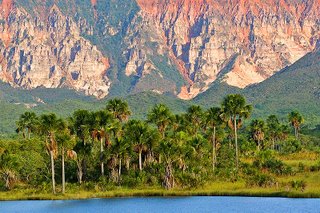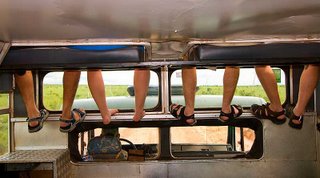.
.
. Mauritia palms (“buriti”) grow mainly in humid areas,
Mauritia palms (“buriti”) grow mainly in humid areas,
forming the so called "veredas"
PHOTO: © Daniel De Granville, 2007
.
.
 Mauritia palms (“buriti”) grow mainly in humid areas,
Mauritia palms (“buriti”) grow mainly in humid areas,forming the so called "veredas"
PHOTO: © Daniel De Granville, 2007
Following on with the sequence of stories about the trip through Brazilian ecosystems that I did in January, today I’ll talk about the region known as the Jalapão, which is turning out to be one of the country’s most promising ecotourism destinations and, surely, a place much sought after by nature photographers.
Located east of the State of Tocantins, on the border with Bahia, Piauí and Maranhão States, the Jalapão has an area of approximately 53,000 km² (20,500 sq mi) covered by typical Cerrado vegetation, with plants such as the “buriti” (Mauritia palm), the “lixeira” (Curatella rough-leafed tree) and the renowned “capim-dourado” (Syngonanthus golden grass) – from which the region’s most typical handicraft is made.
 Articles like baskets, purses, jewelry and ornaments
Articles like baskets, purses, jewelry and ornamentsare made from the golden grass
PHOTO: © Daniel De Granville, 2007
Beyond doubt, the coolest way to know the Jalapão is by staying at Korubo’s safari camp. The whole staff and operation are prepared in such a way that visitors feel entirely at ease and see the region’s highlights, without leaving the environmental awareness behind.
For nature photographers, maybe because the time of year was not the best, I didn’t feel any special potential for wildlife photography (but please keep in mind that I might be spoiled by living near the Pantanal!). The best shooting opportunities were the beautiful landscapes with rivers, waterfalls, mountains, tablelands and dunes.
 Velha (“old lady”) Waterfall, whose impressive volume of water
Velha (“old lady”) Waterfall, whose impressive volume of waterhighly contrasts with the desert-like landscape that surrounds it
PHOTO: © Daniel De Granville, 2007
The only con is that, pretty much like it has been happening with the Amazon and other parts of the Cerrado, the huge soy bean crops – without proper environmental care – pose a serious threat to this ecosystem. The hope now lies in the creation of more conservation units, such as the Jalapão State Park, which can control potentially impacting activities and ensure the maintenance of singular environments found in the region.



No comments:
Post a Comment